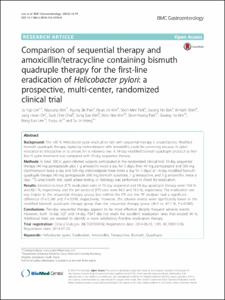KUMEL Repository
1. Journal Papers (연구논문)
1. School of Medicine (의과대학)
Dept. of Internal Medicine (내과학)
Comparison of sequential therapy and amoxicillin/tetracycline containing bismuth quadruple therapy for the first-line eradication of Helicobacter pylori: a prospective, multi-center, randomized clinical trial
- Keimyung Author(s)
- Park, Kyung Sik; Lee, Ju Yup
- Department
- Dept. of Internal Medicine (내과학)
- Journal Title
- BMC Gastroenterology
- Issued Date
- 2016
- Volume
- 16
- Issue
- 1
- Keyword
- Helicobacter pylori; Eradication; Amoxicillin; Tetracycline; Bismuth; Quadruple
- Abstract
- Background ;
The <80 % Helicobacter pylori eradication rate with sequential therapy is unsatisfactory. Modified bismuth quadruple therapy, replacing metronidazole with amoxicillin, could be promising because H. pylori resistance to tetracycline or to amoxicillin is relatively low. A 14-day modified bismuth quadruple protocol as first-line H. pylori treatment was compared with 10-day sequential therapy.
Methods ;
In total, 390 H. pylori-infected subjects participated in the randomized clinical trial: 10-day sequential therapy (40 mg pantoprazole plus 1 g amoxicillin twice a day for 5 days, then 40 mg pantoprazole and 500 mg clarithromycin twice a day and 500 mg metronidazole three times a day for 5 days) or 14-day modified bismuth quadruple therapy (40 mg pantoprazole, 600 mg bismuth subcitrate, 1 g tetracycline, and 1 g amoxicillin, twice a day). 13C-urea breath test, rapid urease testing, or histology was performed to check for eradication.
Results ;
Intention-to-treat (ITT) eradication rates of 10-day sequential and 14-day quadruple therapy were 74.6 % and 68.7 %, respectively, and the per-protocol (PP) rates were 84.2 and 76.5 %, respectively. The eradication rate was higher in the sequential therapy group, but neither the ITT nor the PP analyses had a significant difference (P = 0.240 and P = 0.099, respectively). However, the adverse events were significantly lower in the modified bismuth quadruple therapy group than the sequential therapy group (36.9 vs. 47.7 %, P = 0.040).
Conclusions ;
Ten-day sequential therapy appears to be more effective despite frequent adverse events. However, both 10-day SQT and 14-day PBAT did not reach the excellent eradication rates that exceed 90 %. Additional trials are needed to identify a more satisfactory first-line eradication therapy.
- Publisher
- School of Medicine
- Citation
- Ju Yup Lee et al. (2016). Comparison of sequential therapy and amoxicillin/tetracycline containing bismuth quadruple therapy for the first-line eradication of Helicobacter pylori: a prospective, multi-center, randomized clinical trial. BMC Gastroenterology, 16(1), 79–79. doi: 10.1186/s12876-016-0490-8
- Type
- Article
- ISSN
- 1471-230X
- Appears in Collections:
- 1. School of Medicine (의과대학) > Dept. of Internal Medicine (내과학)
- 파일 목록
-
-
Download
 oak-2017-0053.pdf
기타 데이터 / 552.36 kB / Adobe PDF
oak-2017-0053.pdf
기타 데이터 / 552.36 kB / Adobe PDF
-
Items in Repository are protected by copyright, with all rights reserved, unless otherwise indicated.